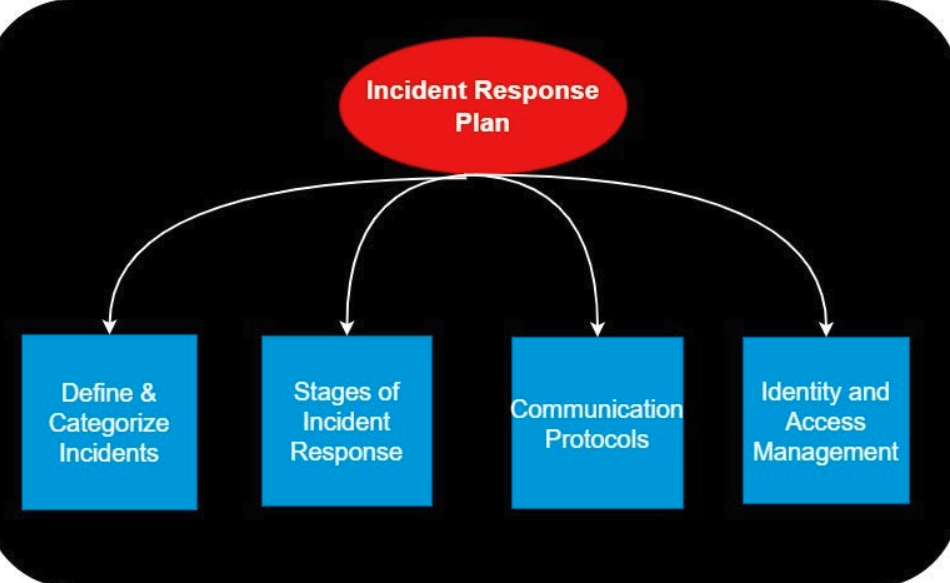
Incident Management Plan (Image by Alloy Software)

Incident Management Plan (Image by Alloy Software)
An Incident Management Plan is a structured approach for handling unexpected and disruptive events in business.
An Incident Management Plan (IMP) is essential for ensuring swift, effective responses to incidents minimizing impacts on operations.
Without an IMP, your businesses face prolonged disruptions, risking customer trust and financial stability.
A well-crafted IMP, tailored to specific business needs, equips teams with transparent procedures, ensuring coordinated, efficient action.
This proactive stance addresses immediate challenges and reinforces a company’s reputation for reliability and preparedness.
On the other hand, the incident management life cycle describes the various stages of an incident, typically including preparation, detection, response, mitigation, and recovery, followed by a post-incident review.
Each stage of this life cycle is addressed within the IMP. The IMP dictates how each phase should be managed, ensuring the response is coordinated, timely, and effective.
So yes, implementing an IMP is a strategic decision to protect business continuity and build a robust corporate culture.
How does IMP become something beyond crisis management? Let’s talk about the whole scenario here.
Developing a robust Incident Management Plan (IMP) indicates an organization’s dedication to maintaining resilience and adaptability in a rapidly changing business environment.
When constructed thoughtfully, this plan weaves together critical elements crucial for handling incidents efficiently and precisely.
These elements, each a crucial component, collectively reinforce your organization’s ability to stand firm against unexpected challenges.
The risk assessment and identification process involves analyzing potential threats and their impact on business operations.
Risk assessment and identification requires understanding the likelihood of various incidents and their possible consequences.
This assessment prioritizes resources and helps craft strategies for different incidents, ensuring that the most critical risks are addressed first.
During incidents, effective communication encompasses timely and transparent information dissemination to all stakeholders, including employees, management, and customers.
The strategy should outline who communicates, through what channels, and the nature of the information to be conveyed.
This ensures everyone is informed and coordinated, reducing confusion and enabling efficient incident handling.
A well-defined incident response team involves assigning specific roles and responsibilities to team members, ensuring each person knows their duties during an incident.
This clarity prevents overlap, ensures coverage of all critical functions, and facilitates a coordinated response to incidents.
Documentation provides a record of incidents and responses. This process involves detailing the incident, response actions taken, and outcomes.
Proper documentation aids in post-incident reviews, helping identify strengths and weaknesses in the response, which is essential for continuous improvement of the incident management process.
Regular training and drills are essential for every aspect of the IT system, including IMP.
Regular training and drills ensure everyone involved in the incident management plan understands their roles within the plan.
These exercises test the plan’s effectiveness and the team’s readiness and highlight areas that need refinement.
So yes, ongoing training maintains a high level of preparedness and ensures a skilled response to incidents.
Remember, developing a strong IMP is like a journey – a work in progress. Keep going back and tweaking your plan based on your dry runs, actual emergencies you’ve faced, and the ever-changing threat landscape out there.
The IMP operationalizes the incident management policy. The policy is a guideline and principal objectives.
The IMP is turning its guidelines and objectives into actionable steps. Consider using these steps as your guide. Personalize them to what your organization really needs.
That way, you’ll have an IMP like a trusty compass in rough weather, helping you steer smoothly through disruptions and keep your business on track.
Developing an Incident Management Plan starts with initial planning and goal-setting. This stage involves defining and aligning the plan’s scope with organizational objectives.
Establishing clear goals for the IMP, such as minimizing response time and limiting operational disruption, is crucial.
This step sets the foundation for the plan, ensuring that it is tailored to meet the specific needs and capacities of the organization.
It also involves engaging key stakeholders to gain insights and support, ensuring the plan is comprehensive and aligned with broader business strategies.
Risk assessment and analysis is a critical step in creating an IMP. It involves identifying potential organizational threats and evaluating their impact and likelihood.
This process should be thorough, considering various scenarios, including natural disasters, cyber-attacks, and other operational disruptions.
The outcome of this analysis helps prioritize risks and informs the development of specific response strategies for each identified risk.
This assessment must be regularly updated to reflect changing circumstances and emerging threats.
Forming a dedicated incident management team and assigning specific roles is essential.
This step involves selecting individuals with the appropriate skills and expertise for various roles within the team.
It’s essential to define these roles clearly, including responsibilities, authority levels, and communication protocols.
This clarity ensures that, in the event of an incident, each team member knows their specific duties, enabling a swift and coordinated response.
Regular training and team-building activities are also crucial to ensure effective collaboration during an incident.
Drafting the IMP is where strategic planning turns into a tangible document. This step involves documenting all the procedures, protocols, and guidelines developed in the previous stages.
The plan should be comprehensive, covering all aspects of incident response, from initial detection to resolution and post-incident review.
The plan must be clear, concise, and accessible to all relevant personnel. Regular reviews and updates to the document are essential to ensure it remains appropriate and effective.
Testing and rehearsing involves conducting drills and simulations to evaluate the effectiveness of the plan and the readiness of the incident response team.
These exercises help identify gaps or weaknesses in the plan, allowing for necessary adjustments.
Regular testing ensures that team members are familiar with the procedures and can act confidently and efficiently in an actual incident.
Feedback from these tests should be used to improve the plan continuously, ensuring it evolves in line with organizational changes and new threats.

Crafting an Incident Management Plan (IMP) is a crucial step. Still, its true value lies in its effectiveness during an actual crisis. Here are some practical tips to elevate your IMP from good to great.
Please always start by mapping out your current incident response capabilities. Assess your strengths and identify areas needing improvement. Engage team members from different departments for a holistic view.
Set clear, achievable goals for your IMP, ensuring they align with your organization’s objectives.
Document every stage, from brainstorming to decision-making. This transparency helps refine the process and ensures that all aspects of incident management are covered comprehensively.
Effective collaboration and communication establish a multidisciplinary incident management team, drawing expertise from various departments.
Make sure you have clear channels of communication, both internally and externally. Regular meetings and updates will keep everyone informed.
Develop a communications plan that details how information will be disseminated during an incident.
This plan should cater to different audiences, including employees, management, and external stakeholders, ensuring timely and accurate information flow.
An IMP is not static; it requires regular review and updates. Incorporate lessons learned from drills, actual incidents, and changes in the business environment.
This proactive approach ensures the IMP evolves and remains relevant. Encourage feedback from all levels within the organization.
Analyze incidents post-resolution for insights. Regular training and refresher courses keep the team adept and ready.
Stakeholder engagement is crucial. Include critical internal and external stakeholders in the planning process.
Understand their needs, concerns, and expectations. Their input can provide valuable insights, leading to a more robust and effective IMP.
Regular updates to stakeholders about changes and improvements in the IMP build trust and ensure alignment with broader business objectives.
Implement technology such as incident tracking and reporting tools for real-time monitoring and management.
These systems should be user-friendly and integrate seamlessly with existing IT infrastructure.
They provide valuable data for analysis, helping to identify trends, response effectiveness, and areas for improvement.
Advanced technology solutions can automate certain aspects of the incident response, increasing efficiency and accuracy.
Going into 2024, it’s becoming pretty clear how crucial it is to have a solid Incident Management Plan (IMP). The business world keeps changing, and so do the types and frequency of incidents we might face.
What’s interesting is that an IMP isn’t just about reacting to problems; it’s actually a strategic tool that gets businesses ready to deal with both the challenges we see now and those we might face in the future.
Here’s the thing: if businesses really dig into some practical tips, focus on working together and communicating well, keep improving their plans, get everyone involved, and use technology smartly, they can make their IMPs way better.
This whole idea of focusing on strong incident management is about more than just keeping operations running smoothly; it’s actually a key part of making sure the business can bounce back and keep going strong, no matter what happens.
So, as your businesses work through the complicated world we live in, a well-thought-out IMP is going to be super important. It’s what’s going to help them handle any disruptions and keep things running without a hitch.